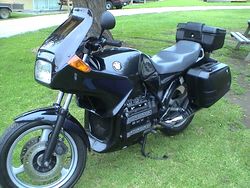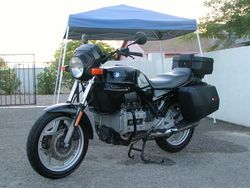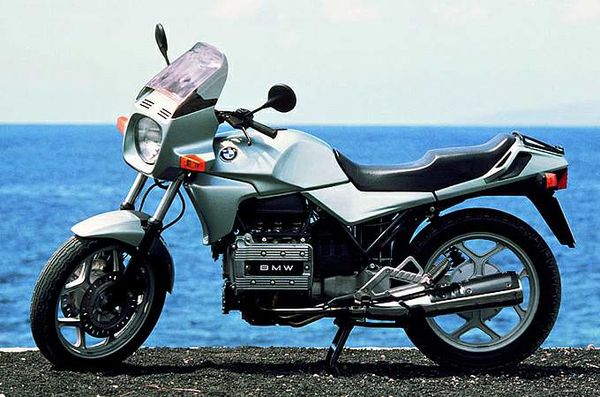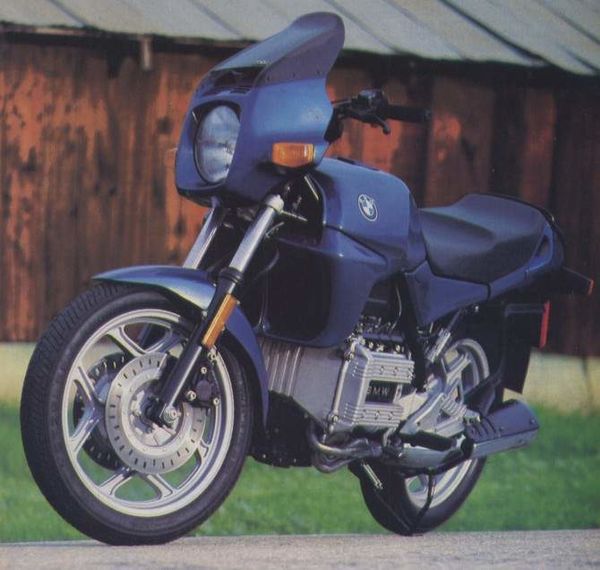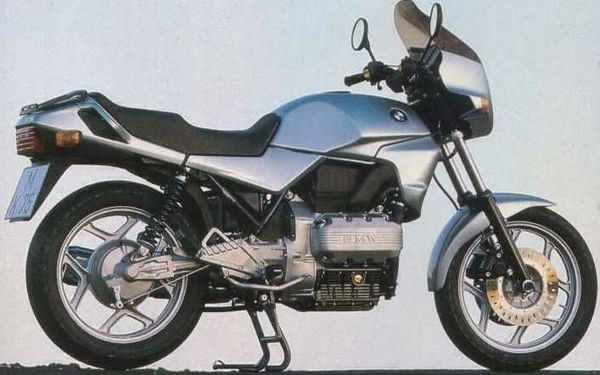BMW K75C
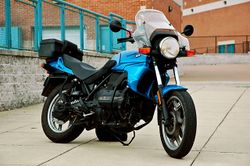 |
|
| BMW K75C | |
| Manufacturer | |
|---|---|
| Also called | K 75 C |
| Production | 1985 - 1995 |
| Class | Naked |
| Engine | liquid-cooled, four-stroke, longitudinal three cylinder, DOHC, 2 valves per cylinder |
| Bore / Stroke | 66.0mm x 66.0mm |
| Compression ratio | 11.0:1 |
| Top Speed | 124 mph (200 km/h) |
| Horsepower | 74.96 HP (55.9 KW) @ 8500RPM |
| Torque | 50.16 ft/lbs (68.0 Nm) @ 6750RPM |
| Spark Plug | NGK D8EA '86-88 |
| Battery | YUASA 51814 '86-88 |
| Transmission | Gear box: 5-speed, manual Final Drive: shaft |
| Final Drive | Shaft |
| Suspension | Front: telescopic fork with hydraulic shock absorber Rear: Monolever swinging arm |
| Brakes | Front: dual 285mm discs, 2-piston calipers Rear: single 285mm disc |
| Front Tire | 100/90-18 56H |
| Rear Tire | 120/90-18 56H |
| Wheelbase | 59.69 inches (1516 mm) |
| Length | 87.4 inches (2220 mm) |
| Width | 35.39 inches (899 mm) |
| Seat Height | 31.89 inches (810 mm) |
| Weight | 236.0 kg (wet) |
| Oil Filter | K&N KN-163[1] |
| Fuel Capacity | 5.55 Gallon (21.00 Liters) |
| Related | BMW K75 BMW K75C |
| Manuals | Service Manual |
The BMW K75 was a was a liquid-cooled, four-stroke, longitudinal three cylinder, DOHC, 2 valves per cylinder standard motorcycle produced by BMW from 1985 to 1995. At the time of its introduction, the K75 was BMW's cheapest motorcycle. It offers a claimed acceleration of 0–60 mph in 4.6 seconds and a top speed of 120 mph (193 km/h). Max torque was 50.16 ft/lbs (68.0 Nm) @ 6750 RPM. Claimed horsepower was 74.96 HP (55.9 KW) @ 8500 RPM.
Engine[edit | edit source]
The engine was a liquid cooled liquid-cooled, four-stroke, longitudinal three cylinder, DOHC, 2 valves per cylinder. A 66.0mm bore x 66.0mm stroke result in a displacement of just 740.0 cubic centimeters. Fuel was supplied via a double overhead cams/twin cam (dohc).
Drive[edit | edit source]
The bike has a 5-speed, manual transmission. Power was moderated via the dry, single plate.
Chassis[edit | edit source]
It came with a 100/90-18 56H front tire and a 120/90-18 56H rear tire. Stopping was achieved via dual 285mm discs, 2-piston calipers in the front and a single 285mm disc in the rear. The front suspension was a telescopic fork with hydraulic shock absorber while the rear was equipped with a Monolever swinging arm. The K 75 C was fitted with a 5.55 Gallon (21.00 Liters) fuel tank. The wheelbase was 59.69 inches (1516 mm) long.
Model designations[edit | edit source]
Various models of the K75 were produced.
- K75, with no fairing
- K75T, US only model with a windscreen, touring bags, engine crash bars, and rear top case
- K75C, with a small handlebar mounted 'cockpit' fairing
- K75S, with sports fixed fairing and lower bars
- K75RT, with full fairing for 'road touring'
S and RT versions have a rear disc brake and 17 inch rear wheels whereas the others have a single leading shoe drum brake and 18 inch rear wheels. A stiffer, "anti-dive" front suspension was added to the S and RT model. Later RT version has a windshield that can be raised or lowered. Some taller riders complain of wind buffeting with the smaller S model stock windscreen.
Engine and transmission[edit | edit source]
All K75 models share the same drivetrain. They are powered by a 740 cc liquid-cooled inline three-cylinder engine with Bosch fuel injection. The US EPA specific engine produce 68 hp while all others produce 75 hp. It utilizes a five-speed transmission with a dry clutch and a shaft-driven final drive. The engine is rotated 90 degrees – designed to be less vulnerable to damage should the cycle fall over.
Background to K75 launch and design[edit | edit source]
The K-series lineup, including the K75 and K100, were not just new models; these designs were radical departures from almost every aspect of previous ones. The K-bikes introduced new technology and refinement for a premium brand. At the time, BMW and Harley-Davidson were the only major manufactures that did not offer liquid-cooled engines. Competing brands, notably of Japanese manufacture, were touting the superiority of their liquid-cooled engines and had introduced low maintenance shaft-drive technology into a growing number of their models.
The K-series offered refinements like computer-controlled fuel injection, all stainless steel exhaust, rust-free aluminum fuel tank, anti-lock brakes or ABS, mono-lever in the rear and single shock absorber, adjustable headlight, high capacity 460 watt alternator, cigarette lighter accessory plug-in, self canceling signal lights. It would take more than two decades for other manufacturers to catch-up. The engine design had excellent vibration isolation. Two different forks manufactures were used: Showa with an outer upper tube diameter of 1.612" and Fichtel and Sachs measuring 1.627".
1985 BMW K 75 C[edit | edit source]
The 1985 MY BMW K 75C is a middle-class naked machine that comes standard with features such as a suspension package composed of a telescopic fork with a hydraulic shock absorber and a Monolever unit in the rear, cast-aluminum wheels, a nose-fairing with a windscreen, a dual seat, passenger grab rails, a rear luggage rack, mid-mounted foot controls and an analogue instrument cluster.
In the tech/engine department, it sports a liquid-cooled, four-stroke, 740cc, in-line three cylinder powerplant mated to a five-speed manual transmission that can reach a maximum power output of 75 horsepower and 68 Nm of torque.
1986 BMW K 75 C[edit | edit source]
The 1986 MY BMW K 75C can reach a maximum power output of 75 horsepower and 68 Nm of torque from its liquid-cooled, four-stroke, 740cc, in-line three cylinder powerplant mated to a five-speed manual transmission. It also boasts features such as a telescopic fork with a hydraulic shock absorber and a Monolever unit in the rear, cast-aluminum wheels, a nose-fairing with a windscreen, a dual seat, passenger grab rails, a rear luggage rack, mid-mounted foot controls and an analogue instrument cluster.
1987 BMW K 75 C[edit | edit source]
The 1987 MY BMW K 75C comes with a telescopic fork with a hydraulic shock absorber and a Monolever unit in the rear, cast-aluminum wheels, a nose-fairing with a windscreen, a dual seat, passenger grab rails, a rear luggage rack, mid-mounted foot controls and an analogue instrument cluster.
In the tech/engine department, it sports a four-stroke, liquid-cooled, 740cc, longitudinal three cylinder powerhouse paired to a five-speed manual transmission, and can reach a maximum power output of 75 horsepower and 68 Nm of torque.
1988 BMW K 75 C[edit | edit source]
The 1988 MY BMW K 75C sports a four-stroke, liquid-cooled, 740cc, longitudinal three cylinder powerplant mated to a five-speed manual transmission, and can produce a claimed 75 horsepower and 68 Nm of torque. Also, it boasts a hydraulic shock absorber and a Monolever unit in the rear, cast-aluminum wheels, a nose-fairing with a windscreen, a dual seat, passenger grab rails, a rear luggage rack, mid-mounted foot controls and an analogue instrument cluster.
1989 BMW K 75 C[edit | edit source]
The 1989 MY BMW K 75C is a naked, middle-class two-wheeler that is sure to fit the taste for a wide category of riders. At its heart lies a liquid-cooled, four-stroke, 740cc, longitudinal three cylinder powerhouse paired to a five-speed manual transmission, that produces a claimed 75 horsepower and 68 Nm of torque.
The key features for this machine would be the telescopic front fork with a hydraulic shock absorber, a Monolever suspension in the rear, cast-aluminum wheels, a nose-fairing with a windscreen, a dual seat, passenger grab rails, a rear luggage rack, mid-mounted foot controls and an analogue instrument cluster.
1990 BMW K 75 C[edit | edit source]
The 1990 MY BMW K 75C boasts a telescopic front fork with a hydraulic shock absorber, a Monolever suspension in the rear, cast-aluminum wheels, a nose-fairing with a windscreen, a dual seat, passenger grab rails, a rear luggage rack, mid-mounted foot controls and an analogue instrument cluster.
In the tech/engine department, this naked sports a liquid-cooled, four-stroke, 740cc, in-line three cylinder powerplant mated to a five-speed manual transmission, and can reach a maximum power output of 75 horsepower and 68 Nm of torque.
In Media[edit | edit source]
References[edit | edit source]
- ↑ 2019 K&L Supply Co Catalog. K&L Supply Co. 2019.
| |||||||||||||||||
